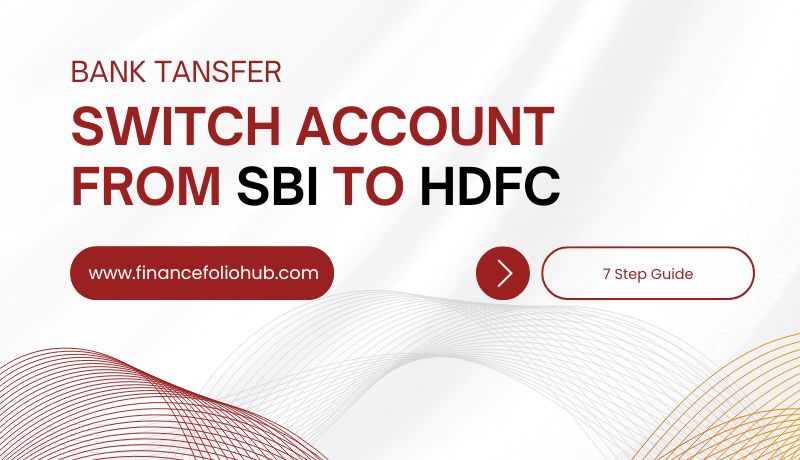Switching your bank account from State Bank of India (SBI) to HDFC Bank in India can be a straightforward process if handled methodically. This guide provides a detailed, step-by-step approach to ensure a smooth transition without disrupting your financial life.
7 Steps to Change SBI To HDFC Account
Step 1: Assess Your Banking Needs and Research HDFC Bank
Before initiating the switch, clearly define your banking requirements and thoroughly research HDFC Bank’s offerings.
- Fees and Charges: Compare account maintenance fees, ATM charges, transaction fees, and any other applicable charges.
- Interest Rates: Review interest rates on savings accounts and fixed deposits.
- Digital Capabilities: Evaluate the HDFC Bank mobile app and internet banking platform for user-friendliness, feature set (bill payments, fund transfers, investments), and online support.
- Branch and ATM Network: Consider the accessibility of HDFC Bank branches and ATMs in your frequent locations.
- Specific Products: If you have specific needs like a salary account, particular loan requirements, or investment accounts, examine HDFC Bank’s relevant product offerings and their suitability.
Step 2: Open Your New HDFC Bank Account
Once you’ve decided on HDFC Bank, proceed to open your new account.
- Online Account Opening: Utilize HDFC Bank’s InstaAccount facility for a quick and paperless process. This typically requires your Aadhaar card (linked to your mobile number) and PAN card. Video KYC is usually available for full digital verification.
- Branch Visit: Alternatively, visit your nearest HDFC Bank branch. Carry original and photocopies of your identity proof (Aadhaar, PAN, Passport, Voter ID, Driving License) and address proof (Aadhaar, utility bills no older than 2 months, or rental agreement). Also bring two passport-sized photographs.
Step 3: Compile a Comprehensive List of All Linked Payments and Deposits
This is a critical step to prevent financial disruptions. Review your SBI bank statements for the past 6 to 12 months to create a detailed list of all recurring transactions:
- Direct Deposits: List your salary, pension, government benefits (like DBT), dividends, and mutual fund Systematic Investment Plans (SIPs).
- Automatic Bill Payments (Auto-debits/ECS): Include utility bills (electricity, water, gas), mobile bills, internet bills, loan EMIs (home, car, personal), credit card payments, insurance premiums, SIPs, and subscription services (OTT, gym memberships).
- Recurring Transfers: Document any automated transfers between your own accounts or to other individuals.
- Linked Accounts: Identify all financial platforms or services linked to your SBI account, such as UPI apps (PhonePe, Google Pay, Paytm), investment/trading platforms, digital wallets, and e-commerce websites.
- Outstanding Cheques: Confirm if any cheques issued from your SBI account are yet to be cleared.
Step 4: Gradually Shift Direct Deposits and Automatic Payments to HDFC Bank
Do not close your SBI account immediately. Maintain both accounts for 1-2 months to ensure all transitions are complete.
- Prioritize Direct Deposits: Start by updating your primary income source (salary, pension) with your employer’s HR department or the relevant institution, providing your new HDFC Bank account number and IFSC code.
- Update Auto-Debits Systematically: Update recurring bill payments incrementally. You can often do this via the biller’s online portal. For loan EMIs, submit a new Electronic Clearing Service (ECS) mandate form to your loan provider with your HDFC Bank details.
- Maintain Buffer Funds: Keep a sufficient balance in your old SBI account to cover any forgotten auto-debits or cheques during this transition period.
Step 5: Transfer Your Remaining Funds to the New HDFC Bank Account
Once confident that all direct deposits and automatic payments are redirected, transfer your funds.
- Online Fund Transfer: Use NEFT, RTGS, or IMPS via your SBI net banking or mobile app to transfer the remaining balance to your HDFC Bank account.
- Cheque/Cash Deposit: Alternatively, write a self-cheque from your SBI account and deposit it into your HDFC Bank account, or withdraw cash from SBI and deposit it into HDFC.
Step 6: Deactivate and Close Your Old SBI Account
After confirming successful migration of all transactions and funds, proceed to close your SBI account.
- Visit Your SBI Branch: Account closure typically requires an in-person visit to your home branch.
- Fill Out the Closure Form: Complete the account closure form provided by the bank.
- Submit Required Documents: Surrender unused cheque leaves, your SBI debit card, and your passbook. Carry identity proof for verification.
- Request Written Confirmation: Obtain a written confirmation or acknowledgment slip from SBI confirming account closure. This is crucial for your records.
- Be Aware of Closure Fees: Inquire about any fees for closing the account within a specific period (e.g., 6 or 12 months from opening).
Step 7: Monitor Your New HDFC Bank Account
For a few weeks after closing your SBI account, consistently monitor your HDFC Bank statements and transaction history to ensure all expected direct deposits arrive and all automatic payments clear as planned.
FAQs
No, it’s highly recommended to keep both accounts active for at least 1-2 months. This overlap period allows you to gradually transfer all direct deposits and automatic payments to your HDFC account without disruption. Closing your SBI account prematurely could lead to missed payments or bounced transactions.
For online account opening (InstaAccount with Video KYC), you typically need your Aadhaar card (linked to your mobile number) and PAN card. For opening an account by visiting a branch, you’ll need original and photocopies of:
– Identity Proof: Aadhaar, PAN, Passport, Voter ID, Driving License.
– Address Proof: Aadhaar, utility bills (electricity, water, gas – not older than 2 months), Passport, Voter ID, Driving License, rental agreement.
– Two passport-sized photographs.
Contact your employer’s HR department or the relevant pension disbursing authority. You will need to provide them with your new HDFC Bank account number and the IFSC code. They will typically have a form or online portal for updating bank details.
For most billers (e.g., electricity, mobile, internet), you can log into their online portal and update your bank details. For loan EMIs or insurance premiums that operate via ECS mandates, you may need to submit a new ECS mandate form to your loan provider or insurer, specifying your new HDFC Bank account details. This form usually requires your signature and may need to be authenticated by HDFC Bank. Some banks/institutions also support NACH (National Automated Clearing House) e-mandate for online updates.
Generally, you’ll need to remove your old SBI account from the UPI app and then add your new HDFC Bank account. The process usually involves:
– Going to the ‘Bank Accounts’ or ‘Payment Methods’ section within the app.
– Selecting your SBI account and choosing the ‘Remove’ or ‘Delete’ option.
– Then, selecting ‘Add New Bank Account’ and choosing HDFC Bank from the list.
– The app will verify your mobile number linked to the HDFC account and help you set up your UPI PIN.
Yes, SBI may levy charges for closing a savings bank account depending on how long the account has been open:
– Within 14 days of opening: Free.
– From 15 days up to 1 year of opening: ₹500 + GST.
– After 1 year of opening: Free. Different charges may apply for current accounts or specific account types like BSBD (Basic Savings Bank Deposit) accounts.
The account closure process at SBI typically requires a visit to your home branch. Once all required documents are submitted and formalities completed, the account closure may take a few business days. Always request a written confirmation of closure.
If an auto-debit attempts to clear from a closed or zero-balance SBI account, it will likely fail due to insufficient funds or an inoperative account. You might incur a bounced transaction fee from the biller. It’s crucial to diligently update all recurring payments to your HDFC account before closing the SBI account to avoid such issues.
Yes, you can easily transfer funds using NEFT (National Electronic Funds Transfer), RTGS (Real-Time Gross Settlement), or IMPS (Immediate Payment Service) through SBI’s net banking or mobile banking app. These are secure and efficient ways to transfer your balance.
You will need to clear any outstanding dues or negative balances in your SBI account before the bank will approve the closure request. This includes any maintenance charges, overdrafts, or other fees.


